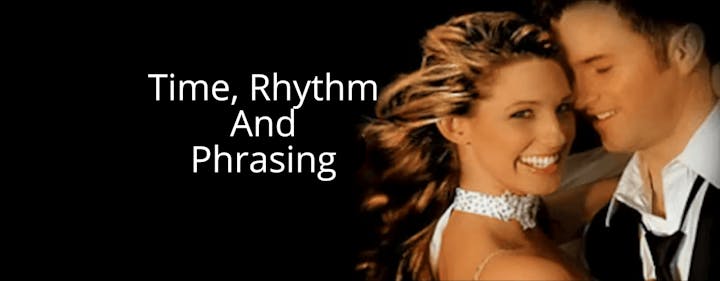TIME, RHYTHM, AND PHRASING
Time:
The control of the speed of the action (Webster’s New American);
Thedancersability to transfer weight on the correct beat of music for the dance
being done;Timing Syncopations requires the Kicks to be on the beat; the steps
to be on the; counts.
TEACHING NOTE: If you have ever seen a couple perform a very difficult move
and it received luke warm applause, and then saw a couple perform a simple
move that hit the music just right so that it made the crowd cheer , then you
witnessed precise timing!
This should be taught from day one. The dancer should think in terms of body
movement rather than foot placement. The feet can hit the floor on the beat but
the body can still be off time if the CPB lands late!
Rhythm:
Rhythm Refers to the steady beat of the music to which we dance; Also
canreferto a dance rhythm, such as a Cha Cha rhythm or Swing rhythm.
Unit: The smallest increment of dance. Most music has a Down Beat followed by
an Up Beat creating a 2 beat cycle we call a 2 beat Unit! In Waltz there is a
Down Beat followed by 2 Up Beats creating a 3 Beat Unit! Therefore, All basic
dance rhythms are 2 beats or in Waltz 3 beats!
Common Rhythms: O = a step, / = a Non Step or as hold
How many beats are in the basic pattern of each dance?
* What are the similarities? Differences?
Knowing the basic rhythm of a dance will help you keep in time to the music!
Syncopation
Rearrangement of the metered beat.
For the dancer, it is the rearrangement of the weight changes within the“2 beat” rhythm.
TEACHING NOTE: The understanding of Syncopations has developed significantly
in the past few years. In West Coast Swing people have been awe struck over
syncopated foot work. With the benefit of the “Universal Unit System” we are
able to break down all the interesting variations that we want so much, and then
duplicate them!
The 2 beat rhythm can be broken down into 6 parts to help us define
syncopations & body movements – & a 1 & a 2
* see Skippy’s update 10/15/94 ” Advanced Understanding of the TWO BEAT
INCREMENT ”
Phrasing:
A basic mini phrase is 1 “set of 8” beats in 4 beat music. 4 beat music has a
heavy measure (4 beats) & a light measure (4 beats ) that equals an 8 count
mini phrase. A basic mini phrase is 1 “set of 6” beats in 3 beat music ( Waltz ).
Waltz has a heavy measure (3 beats) & a light measure (3 beats) that equals 6
beats .
* Try to hear the heavy measures & light measures .
Teaching or learning to music that has simple phrasing will condition the student
to hear the complicated phasing of contemporary music. A Major Phrase is a
specific number of “sets of 8” that have been combined to form a chorus or any
musical grouping that is a complete musical thought. Most minor phrases are 16
beats ( 8 + 8 ), or in Waltz 4 set of 6 beats = 24. Most major phrases are 32 (4
sets of 8) , or in Waltz it can be 8 sets of 6 = 48
TEACHING NOTE: “Basic Phrasing” can be 32 beats of music. Standard “Blues ”
Phrasing is 6 “sets of 8” 48 beats! Some songs have other than standard
phrasing, but all music phrases to some specific musical skeleton . Discovering
how to hear the phrasing in a piece of music allows the dancer more creativity.
It is vital information for the Competitor, Teacher & Choreographer! Remember –
Dancing to music is rhythmic movement of the body to the beat of music. If we
can enhance our understanding of the music we can greatly improve our
interpretation of it! * listen to some music & find the mini & major phrases.
Pulsing A regularly recurring accent in the music
To accent all the Up Beats or all the Down Beats in a specific dance. If a piece
of music pulses a specific beat it helps your dance if you can pulse the same
way , it will give your dance more “Life”!
Swing dances on the Down Beat but pulses on the Up Beat. Cha Cha breaks on
the 2 but accents the “1” & “5” & pulses the down beat. * Count your dance 1-
2- 3-4- 5-6- 7-8. Then count it &1 &2 &3 &4 &5 &6 &7 &8.
* Finally count it
&a1 &a2 – &a3 &a4 – &a5 &a6 &a7 &a8 and you can feel it pulse !
Rhythm Breaks & Extensions Rhythm Breaks are a 4 beat separate pattern that
breaks from the standard rhythm of the dance, either to complete a phrase, add
variety or because something on the music dictated a particular feeling.
Single Rhythm Breaks – Variation of “Slow -Slow”, ” step kick-step kick” etc.Count “1-2 3-4”
Double Rhythm Breaks – Variations of pivots, grapevines, rock steps etc.Count “1-2 3-4”
Triple Rhythm Breaks – Hook triples, Swivel triples, Shuffles etc. Count “1&23&4&56 Extended Step Patterns will all be extended by 2 beats ( a 6 count becomes an 8 count by adding 2 beats) These are particularly effective for forming Links to hit the break in the music.They are ALWAYS formed in two beat increments (Waltz 3 beat & 6 beat increments to stay in phrase with the music).
If you do not you will switch to the Up beat. Please note that both can be Syncopated Rhythms!
Article by Jay Byam
Are you ready to start dancing? check out STEP N DANCE for Salsa & Bachata Dance Classes
post by Tony Duarte | Dance Tips & Articles











